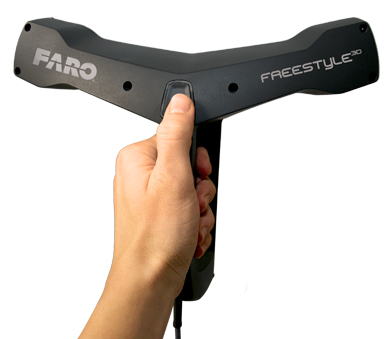Improve Scanning Results for the Freestyle Scanner

Overview
You get consistent high-quality results and the most efficient workflow when you use best practices for scanning with the FARO Freestyle Scanner. Before you begin your project, review the video and the list below for tried-and-true pointers that yield foolproof and accurate point cloud data.
Video
In this 5-minute video, watch how FARO Application Engineer Si Horton demonstrates how to properly use and handle the Freestyle3D.
Setup
- Follow the guidelines for calibrating your Freestyle3D before you begin a scanning project.
- Make sure that the object you are scanning is within the specified maximum and minimum distance from the object to the scanner (min. 50cm, max. 3m)
- Make sure that the object you are scanning is not closer than the minimum range.
- Ensure the object you are scanning is secure in place and does not move.
- When scanning a homogeneous object, make sure to use enough targets on the surface and take care to place the targets properly.
- If the number of features on the object is low or badly distributed, try moving the sensor's field of view to areas with more structures.
Lighting
Like taking a nice picture with your camera, having a blend of light and dark contrast on the features of interest on the scan object is the key to getting the best scan data density and coverage.
- If scanning out of doors, pick a time of day when the position of the sun is advantageous.
- If lighting conditions do not produce adequate contrast (are too light or dark), use the scanner's auto flashlight to get better results.
- Avoid capturing objects that are in direct bright sunlight.
- Objects or surfaces may have increased noise if they are directly illuminated by bright sunlight.
- Scan data in areas of the object that produce glare or have low contrast may be limited or non-existent.
- Shield the object with a shade, tarp, or tent to avoid glare and increase contrast.
- Avoid having only ...
- One monotonous color to the objects in the field of view. Contrast is needed to get thorough coverage of scan data. If this is the case, use a wide-nibbed ink marker, such as a Sharpie, to add a contrasting color in areas of interest. You can add bars of random lines or zig-zags on the object to add contrast.
- Shiny surfaces in the field of view, for example metal rails or high-gloss lacquer. If you are not able to scan shiny areas, treat these with anti-glare spray.
- Highly light absorbing surfaces in the field of view, for example black furniture. If you are not able to scan dark areas, treat these with developer spray.
- Watch the screen during scanning. If you see the sun symbol, it indicates lighting problems. If you see a circle symbol that is half-filled, it means there are contrast issues. Stop scanning and correct these issues before you continue.
Environment
- Temperatures lower than 0°C and higher than +40°C may influence the performance of both the Freestyle and the tablet computer or notebook.
- For applications requiring the highest degree of accuracy, such as reverse engineering, or when working in lower temperature ranges, turn the sensor on and warm it up until the internal temperature stabilizes.
- If the temperature of the sensor is above or below the specified range, capturing is still possible but the temperature may have an impact on the measuring accuracy.
- Strong dust formation, fog, rain or snowfall may result in bad measurements. Avoid scanning under these conditions.
- When capturing outdoors or in dirty surroundings, protect both the sensor and the tablet computer from liquids, humidity, dust, and dirt that may damage the electronic components and seals.
- The tablet computer or notebook used with the Freestyle may be less resistant to stress than the sensor and could become damaged in certain environmental conditions.
Scan Movement
- Move the Freestyle slowly and constantly in circles or loops.
- Avoid abrupt movement, as it may lead to inaccurate scan data and you could lose track of what you have already scanned.
- Avoid capturing long sequences.The Freestyle captures about 7-8 frames per second, which is equivalent to a recommended maximum scan-time of 2 minutes.
- Try to finish a scan at the place where you began. This helps to cause loop-closing.
- Watch the display during capturing. As long as the captured object appears tinted green, the point density is high. If the object appears tinted yellow, the point density is lower.
See Also
- Calibration Guidelines and Procedures for the Freestyle3D
- Quick Start Guide for the Freestyle3D
- User Manual for Freestyle3D, SCENE Capture, and SCENE Process
Keywords:
tips, improve, increase, improve, compensate, compensation, calibration, best results, accuracy
